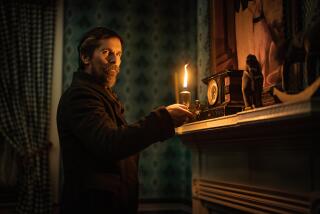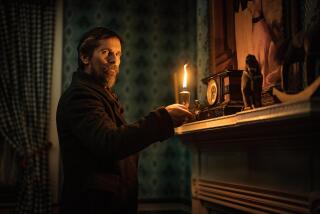Tracing the Tell-Tale Footsteps of Edgar Allan Poe
- Share via
BALTIMORE, Md. — As I slowed our rental car in the mean streets of inner Baltimore, a muscular ghetto teen-ager approached us and my wife shouted, “Close the windows! Lock the doors!”
The teen-ager drew up beside my wife’s window. “If you’re looking for the Poe house,” he said, “it’s on your left.”
Although Edgar Allan Poe wrote romantic poetry and science fiction, his tales of horror define him in the eyes of Americans today. The very act of visiting the houses in which he lived can be an exercise in sheer terror.
While I was sniffing around Poe’s low-ceilinged cottage in the Bronx, with its cramped rooms and stifling, still air, the walls began to close in on me. I thought of “The Pit and the Pendulum.” Or was it “The Premature Burial” or, even, “The Oblong Box”?
I escaped to Poe Park. There I asked a caretaker to let me use the restroom. Carefully, he unlocked one chain and then another. I descended deep into the dankest hole in the Bronx, accompanied by flying and crawling creatures of every description.
When I emerged, a crowd had gathered. “No one ever goes down there!” said one quivering man.
I turned to the caretaker.
“Not since the killings,” he explained.
At Poe’s Philadelphia home I began to walk down the steep and narrow stairway to the basement. I asked my 11-year-old daughter to join me. “No way,” she said. And it was no wonder. In this house, Poe wrote “The Tell-Tale Heart.”
The Poe trail is a long and scenic one and much of it is accessible to travelers, but not recommended for those of faint heart or too-vivid imagination.
It begins at the University of Virginia in Charlottesville, where Poe’s cheerless dorm room at No. 13 West Range on McCormick Road is preserved as it looked in 1826 when he lived there, gambling and drinking himself deeply into debt.
It was there that Poe read his poems to his classmates and studied the classics that were to inspire his most famous words:
To the glory that was Greece,
And the grandeur that was Rome.
The trail picks up in the narrow brick house at 203 N. Amity St. in Baltimore. Here Poe found the love that was to inspire and haunt him for the rest of his life. She was Virginia Clemm, his first cousin, whom he married on Sept. 22, 1835, when she was 13 and he 26.
Virginia was “Annabel Lee,” and she was the inspiration for the short stories “Ligeia” and “Eleonora” as well as the poem “Ulalume.”
The tiny, two-bedroom house is so hellish in summer that it is kept open for only four hours a week, and potential visitors are warned of the hazards in a recorded telephone message.
No one warned Poe and Virginia, who crammed into this cracker box like rats from 1832 to 1835 with their senile grandmother as well as Virginia’s mother and brother. Poe became a heavy user of opium during this period.
In this house he wrote “MS. Found in a Bottle,” his first commercial success. Here too he created the mysterious Poe persona by which we know him today, the spectral wraith cloaked entirely in black.
From Baltimore the Poes moved to Richmond, Va., where Poe had lived as a young orphan. His homes there are not preserved, but the Poe Museum at 1914-16 E. Main St. does a remarkable job of documenting his tortured yet extraordinarily productive life.
Poe enjoyed his most fruitful years in Philadelphia, where he published 31 stories. His home at 532 North 7th St. is administered by the National Park Service. There, in the front room on the second floor, he wrote “The Gold Bug,” “The Tell-Tale Heart,” “The Black Cat,” “The Pit and the Pendulum” and the early drafts of his most-quoted poem, “The Raven.”
In the first draft, the raven was an owl.
Poe lived in the Philadelphia house from 1842 to 1844. Frequently his mother-in-law locked him in his room to keep him from going to taverns, but perhaps not frequently enough. Once he escaped to New York, broke into the home of an old flame, by then married, and refused to leave until she sang “Come Rest in This Bosom.” His mother-in-law found him in the woods--filthy, starving, and out of his mind.
On another occasion he ran off to Washington and turned up in the White House, where he demanded to see President John Tyler about a job. Tyler was a fan of Poe’s and would have been happy to see him under other circumstances. But Poe was drunk on port and wearing his coat inside out, and Tyler’s son Robert turned Poe away.
On April 6, 1844, the Poes headed to New York and then, as Virginia’s health declined, they moved on to the bucolic suburb of Fordham, today part of the Bronx. Their cottage there, like their other homes, is tiny and grim, and Virginia’s bedroom is not much larger than a closet.
Poe was an international figure by this time, but lived in poverty. His poems were reprinted widely, but he received scant royalties. Whatever he earned he lost in bad investments.
Throughout his life Poe earned occasional pocket money as an editor, a craft noted then for the drunkenness of its practitioners.
On Jan. 30, 1847, his treasured child bride, Virginia, died at Fordham of tuberculosis. She was 24.
For the moon never beams without bringing me dreams
Of the beautiful Annabel Lee;
And the stars never rise but I see the bright eyes
Of the beautiful Annabel Lee;
And so, all the night-tide, I lie down by the side
Of my darling, my darling, my life and my bride,
In her sepulchre there by the sea--
In her tomb by the side of the sea.
Virginia Poe was buried in the graveyard of the Fordham Dutch Reformed Church in fine linens supplied by Marie Louise Shew, a devoted family friend.
After Virginia’s death, Poe called on Mrs. Shew. He complained about the clanging coming from the belfry of nearby Grace Church. He began taking notes at Mrs. Shew’s, and in his low second-story chamber at Fordham completed “The Bells.”
The house, which then stood at the top of Fordham Hill, was moved 450 feet north in June, 1913, to its present location at Kingsbridge Road and Grand Concourse.
The Poe trail ends in Baltimore. On Oct. 13, 1849, a Baltimore Sun printer found Poe passing in and out of consciousness at Cooth and Sergeant’s Tavern. He was taken to Washington College Hospital, where he died four days later. No autopsy was performed.
He was buried in the Westminster Presbyterian churchyard at Fayette and Green streets, beside his beloved Virginia--whose remains were transferred there after Poe died--and his aunt and mother-in-law, Maria Poe Clemm. At the time of his death Poe was 40.
If you visit Poe’s grave on his birthday, Jan. 19, you will not be alone. This year 500 people sang “Happy Birthday, Dear Edgar” at a midnight ceremony at Westminster Presbyterian Church. And for the 38th consecutive year, a man cloaked in black left three red roses and an open bottle of Martel cognac at Poe’s grave.
More to Read
Sign up for The Wild
We’ll help you find the best places to hike, bike and run, as well as the perfect silent spots for meditation and yoga.
You may occasionally receive promotional content from the Los Angeles Times.






